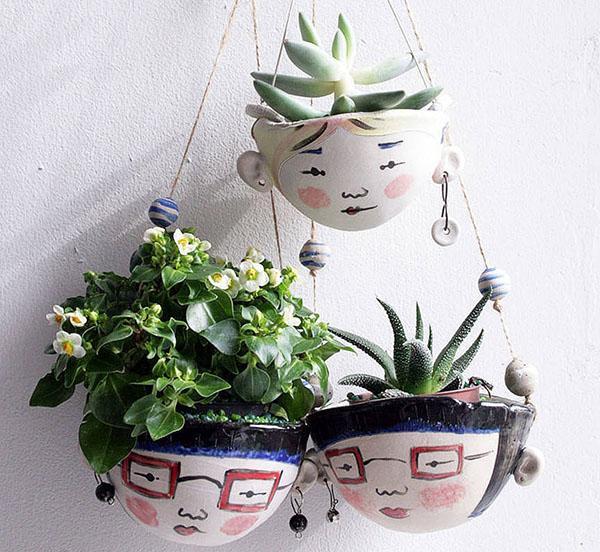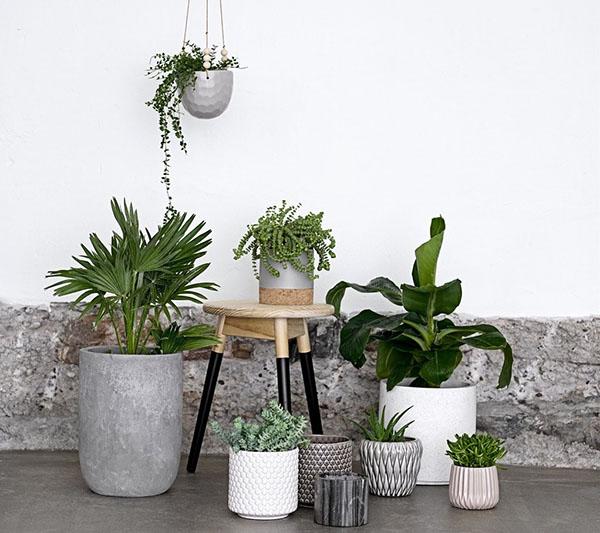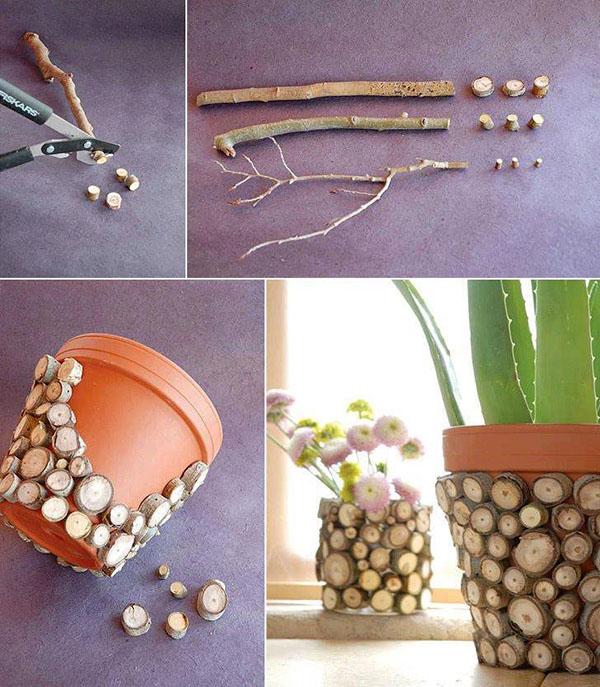Useful decoration for summer cottages and houses - flower pots
 The charm of the most beautiful and well-groomed plants will not be complete if they are planted in different-colored pots that differ in shape, size, material from which they are made. An excellent solution to the problem is a flower pots. Store-bought or handmade, they complete the look of the collection on windowsill and will help to decorate the suburban area.
The charm of the most beautiful and well-groomed plants will not be complete if they are planted in different-colored pots that differ in shape, size, material from which they are made. An excellent solution to the problem is a flower pots. Store-bought or handmade, they complete the look of the collection on windowsill and will help to decorate the suburban area.
The choice of ready-made planters for indoor and garden plants

- the price of the sample you like;
- destination pots;
- the size of the pot to be decorated;
- compliance with the style of the interior or landscape design;
- practicality of the product.
Most often, flower growers prefer flower pots made of polymer materials, fired ceramics or clay, glass.
Planter for flowers made of plastic
 The most affordable samples are made from plastic. They are easy to clean and can be used indoors and outdoors. Due to the presence of drainage holes and the ability to easily make new ones, the plants in the pots are protected from root decay. Another useful quality is lightness, which is important if a florist needs a hanging planter for ampelous plants or a spectacular garland of their flower pots. Despite the thin walls, the container in the sun does not heat up to critical temperatures, does not cause overheating of the soil and root system.
The most affordable samples are made from plastic. They are easy to clean and can be used indoors and outdoors. Due to the presence of drainage holes and the ability to easily make new ones, the plants in the pots are protected from root decay. Another useful quality is lightness, which is important if a florist needs a hanging planter for ampelous plants or a spectacular garland of their flower pots. Despite the thin walls, the container in the sun does not heat up to critical temperatures, does not cause overheating of the soil and root system.
If desired, plastic pots can be easily decorated with fragments of wood, textiles, beads, or simply painted using safe and bright acrylic paints.
Store-bought plastic planters can be easily transformed with a roll of rope and glue. The side surface treated with it is tightly wrapped with a twine or cord.
 However, with a lot of advantages, plastic pots have a couple of disadvantages. They are not too sturdy when used outside the home, and the products cannot be called original in any way.
However, with a lot of advantages, plastic pots have a couple of disadvantages. They are not too sturdy when used outside the home, and the products cannot be called original in any way.
Ceramic pots
 Ceramics of various types have long been used to make flower pots and pots. Clay is incredibly malleable. It can take on a variety of forms, natural material stores the warmth of the master's hands, transferring it to the interior or summer cottage.
Ceramics of various types have long been used to make flower pots and pots. Clay is incredibly malleable. It can take on a variety of forms, natural material stores the warmth of the master's hands, transferring it to the interior or summer cottage.
When choosing a ceramic planter, you should pay attention to the presence of a drainage hole, as well as to the outer coating.
Unglazed clay retains porosity, which improves the microclimate inside the pot, but reduces the longevity of the flowerpot. When watering with tap water, sloppy stains may appear on the walls. Outside the house, containers are threatened with destruction:
- high air humidity;
- a sharp change in temperature, especially freezing and thawing.
Ceramic painted or coated with glaze looks very impressive and is much stronger, but it heats up slowly and does not remove excess moisture well.
 Due to the large weight for ceramic products, especially when making hanging flower pots with your own hands, you need a reliable fastening. It's easy to make with sturdy twine and macrame tricks.
Due to the large weight for ceramic products, especially when making hanging flower pots with your own hands, you need a reliable fastening. It's easy to make with sturdy twine and macrame tricks.
Glass planter for flowers
 Transparent or colored glass is a fragile but effective material that will help to decorate the interior and make the house unique.
Transparent or colored glass is a fragile but effective material that will help to decorate the interior and make the house unique.
At the same time, having shown imagination, making such a planter with your own hands for indoor flowers is not difficult at all.
As a base, you can take suitable sized glass jars, glasses, vases, or even a small rounded aquarium. By connecting the vessels with a rope, fixing them on a wooden stand, you can build a garland for flowers, make a planter for several pots at once.
How and from what to make a flower pots with your own hands
 The decoration of the windowsill and the garden will be pots that were not found in the store, but made by a florist himself. Such samples are usually:
The decoration of the windowsill and the garden will be pots that were not found in the store, but made by a florist himself. Such samples are usually:
- many times cheaper than analogs from the store;
- created taking into account the tastes and preferences of the master;
- are unique.
But, relying on his imagination, the florist needs to remember about the reliability of the future pots, safety and practicality. It is especially important to take into account the variability of the weather and the influence of external factors if you have to assemble pots for the garden with your own hands.
 The most popular materials suitable for this job are:
The most popular materials suitable for this job are:
- wood, including planks, bamboo, dry branches collected from the garden;
- cement mixtures that, after hardening, turn into durable, moisture-resistant structures;
- durable types of twine and rope from which wicker pots are made;
- textiles treated with wear-resistant paint.
It is not at all necessary to go to the store for original pots or materials for its manufacture.
One has only to look around to notice things that are out of use, but that can turn into a unique interior or landscape object.
DIY hanging flower pots

Hand-made pots for the home are a great occasion to show your imagination and demonstrate your ability to create practical and completely unique things.
The simplest option is a hanging planter using macrame technique. Woven to fit the pot, it is:
- fits perfectly into the interior;
- decorates any container in which an indoor flower grows;
- can be used for ordinary and ampelous plants;
- in combination with others, it forms a multi-tiered garland that saves space on the windowsill and gives the window a unique look.
In addition, the planter allows you to significantly improve the lighting of plants and simplifies maintenance with a large number of flowers in the house.
 When choosing a rope for weaving, it is better to give preference to samples made of wear-resistant fiber that does not stretch under load, does not fade in the sun and is not afraid of moisture. The same requirements apply to wicker pots for the street.
When choosing a rope for weaving, it is better to give preference to samples made of wear-resistant fiber that does not stretch under load, does not fade in the sun and is not afraid of moisture. The same requirements apply to wicker pots for the street.
Floor and table planters for flowers
 Large plants such as indoor lemon, monstera, ficus or lush fern are great home decorations. To make them look even more spectacular, the pot can be put in the original planter.
Large plants such as indoor lemon, monstera, ficus or lush fern are great home decorations. To make them look even more spectacular, the pot can be put in the original planter.
It is not always possible to choose an option of a suitable design and size, and everyone can make a high floor planter for flowers on their own.
One of the options is a cement planter. As a basis, a quickly solidifying mixture is taken, which is poured into a prepared form and after a while a strong casting-pots are obtained. Another way to use the material is to drink a textile rag with it and give it a suitable look, wait for the composition to dry. This pots can be used in the home and garden. For a greater decorative effect, the casting is painted and even covered with mosaics.
 A box of a suitable shape will serve as an excellent planter for a large flower. It is preliminarily sanded, treated with a moisture-proof varnish or painted. To protect the floor and other surfaces, such as a table under a wooden flower pot, a tray is placed on the bottom to collect excess moisture. The space between the pot and the planter can be filled with coconut fiber.
A box of a suitable shape will serve as an excellent planter for a large flower. It is preliminarily sanded, treated with a moisture-proof varnish or painted. To protect the floor and other surfaces, such as a table under a wooden flower pot, a tray is placed on the bottom to collect excess moisture. The space between the pot and the planter can be filled with coconut fiber.
To simplify the care of a large green pet, to protect the plant from moisture deficiency and drying out, pots with a built-in irrigation system will help.You can buy it or make it yourself from auxiliary materials.
 In addition to the container for the pot, there is a cavity for water and a tube for filling it, as well as a system of holes that supply moisture to the roots and remove excess moisture. A similar design for flowers of all sizes can be assembled at home. It will be useful both on the windowsill and in the garden, especially when the plants are deprived of the daily attention of the grower.
In addition to the container for the pot, there is a cavity for water and a tube for filling it, as well as a system of holes that supply moisture to the roots and remove excess moisture. A similar design for flowers of all sizes can be assembled at home. It will be useful both on the windowsill and in the garden, especially when the plants are deprived of the daily attention of the grower.
 The simplest pots with auto-irrigation can be made from a regular plastic pot. The main thing is that it is of a suitable size, and its bottom has many large drainage holes. A shipping container in which flowers arrive at the store is perfect. Under the drainage, a mosquito net made of plastic is laid on the bottom. It will not let the soil wash out. Several nylon cords are threaded through the holes so that the ends hang freely.
The simplest pots with auto-irrigation can be made from a regular plastic pot. The main thing is that it is of a suitable size, and its bottom has many large drainage holes. A shipping container in which flowers arrive at the store is perfect. Under the drainage, a mosquito net made of plastic is laid on the bottom. It will not let the soil wash out. Several nylon cords are threaded through the holes so that the ends hang freely.
By placing such pots with home or garden flowers on gravel in a tray filled with water, you can be sure that the plant will not suffer from drying out. The liquid will rise to the ground along the rope, but will not cause root rot.